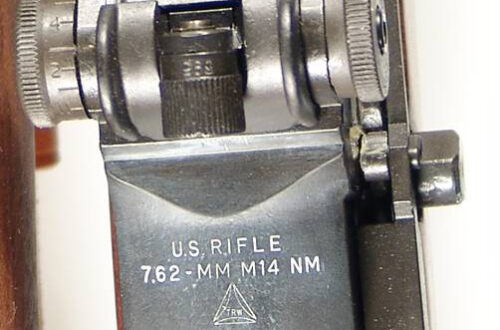
Sample of United States Rifle Model of 1917
As a serious collector of all U.S. martial arms, I have long awaited publication of a collector-oriented book on the United States Rifle, Model of 1917. Even though the Model 1917 was the predominant rifle of U.S. troops in the “war to end all wars,” it has been largely ignored by collectors. In my opinion, one of the reasons for this neglect is that until now there has not been a book that specifically addresses the type of information that we collectors seek. In order for collector-interest to advance for a particular model of firearm, detailed collector-oriented information must be generally available. Regardless of the model of arm and its manufacturer, the two basic questions remain the same: “When was it made?” and “What did it look like when it was manufactured?” Presenting a large enough sampling of original rifles that correlates serial number with barrel date is a great help in determining the originality of the barrel to the receiver. Further, those of us who have sought to add a suitable Model 1917 rifle to our collections have faced the puzzlement of what all of those letters and numbers stamped beneath the eagle heads mean. Which parts should be on my rifle if it is original?
Until now there was no way to answer these questions. A collector could not determine what was original and what had been replaced. Nick Ferris, in his fourth book, has corrected that lack of key information. With this book Nick tells us approximately when our M1917 rifles were made and what they looked like when they left the Winchester, Remington, and Eddystone plants.
One of my pet peeves, and a sore spot with many who collect and discuss the United States Rifle, Model of 1917, is what to call it? There is no other 20th century U.S. Martial Arm that has suffered from so many incorrect nick names. We have all heard every imaginable misnomer: Pattern 17, P17, P-17, ’17 Enfield, US Enfield, Eddystone (when used as an all-encompassing general term), and on and on! All of these names are wholly incorrect as well as inappropriate. Accurate and acceptable names include Model 1917, M1917, or ’17 rifle. It is the responsibility of all informed collectors to make an effort to call the Model 1917 rifle by its proper name. We should correct our fellow collectors when they use one of those incorrect nick names. If this book accomplishes nothing else, it will be a success if it puts to rest all of those meaningless names!
As collectors of U.S. martial arms we are curators, temporary custodians if you will, of the items within our collections that we are holding for the next generation of collectors (i.e., “If you don’t sell it your wife or kids probably will!”). Also, as collectors it is incumbent upon us, regardless of if we are published authors or not, to advance the knowledge of the arms that we study and to pass that knowledge on to new and future generations of collectors. The Great War, to become known a number of years after-the-fact as World War One, was the pivotal event of the first quarter of the 20th century. In addition, it set the stage for the outbreak of World War Two. It is only natural that American interest gravitates more towards study of World War Two than to World War One due to the number of our fellow citizens involved in each and the separation of time between the two events. But to study the latter without understanding the former is to do a great disservice to the history of both wars and the men who fought them. The Great War affected the people of Europe and England much more so than it did the average citizen of the United States, but with the large deployment of American boys “over there” and the number of sons killed and wounded, it is important that we U.S. martial arms collectors devote a portion of our collections and study to the arms of World War One. The Model of 1917 was the prevalent rifle with which U.S. soldiers and Marines were armed during the Great War. We owe it to their memory to preserve both the arms themselves and the information we develop on these ubiquitous rifles. In addition, a collection of 20th century U.S. martial arms cannot be considered complete without a representative Model 1917 rifle; a suitable example is a “must-have.” It is my sincere hope that this book will help you to understand the United States Rifle, Model of 1917 that you already have in your collection or aid you in adding a suitable example.
This excerpt is from United States Rifle Model of 1917 by C.S. Ferris, FOREWORD By Scott Duff
This book is included in the US Infantry Book Bundle or you can
purchase the book by itself here: United States Rifle Model of 1917




